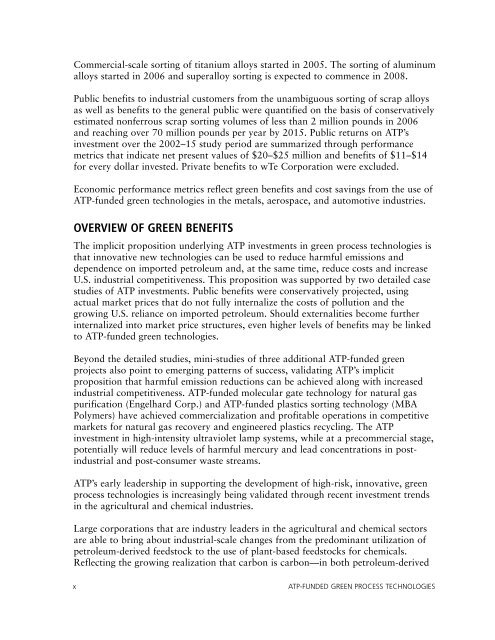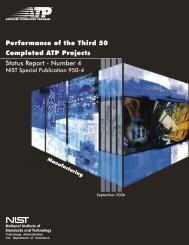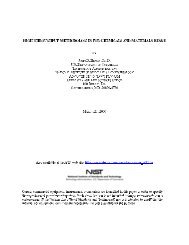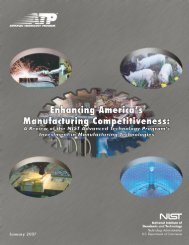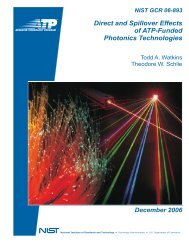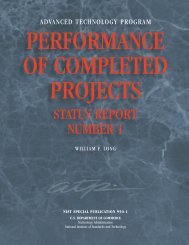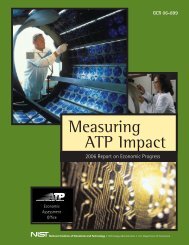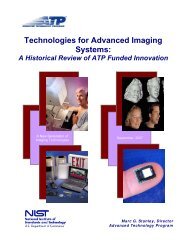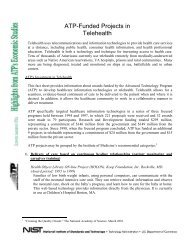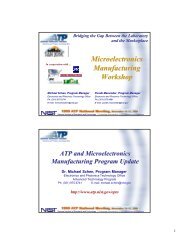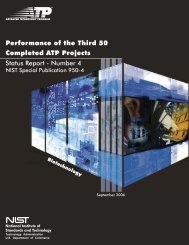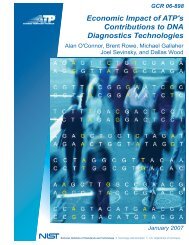ATP-Funded Green Process Technologies - NIST Advanced ...
ATP-Funded Green Process Technologies - NIST Advanced ...
ATP-Funded Green Process Technologies - NIST Advanced ...
You also want an ePaper? Increase the reach of your titles
YUMPU automatically turns print PDFs into web optimized ePapers that Google loves.
Commercial-scale sorting of titanium alloys started in 2005. The sorting of aluminum<br />
alloys started in 2006 and superalloy sorting is expected to commence in 2008.<br />
Public benefits to industrial customers from the unambiguous sorting of scrap alloys<br />
as well as benefits to the general public were quantified on the basis of conservatively<br />
estimated nonferrous scrap sorting volumes of less than 2 million pounds in 2006<br />
and reaching over 70 million pounds per year by 2015. Public returns on <strong>ATP</strong>’s<br />
investment over the 2002–15 study period are summarized through performance<br />
metrics that indicate net present values of $20–$25 million and benefits of $11–$14<br />
for every dollar invested. Private benefits to wTe Corporation were excluded.<br />
Economic performance metrics reflect green benefits and cost savings from the use of<br />
<strong>ATP</strong>-funded green technologies in the metals, aerospace, and automotive industries.<br />
OVERVIEW OF GREEN BENEFITS<br />
The implicit proposition underlying <strong>ATP</strong> investments in green process technologies is<br />
that innovative new technologies can be used to reduce harmful emissions and<br />
dependence on imported petroleum and, at the same time, reduce costs and increase<br />
U.S. industrial competitiveness. This proposition was supported by two detailed case<br />
studies of <strong>ATP</strong> investments. Public benefits were conservatively projected, using<br />
actual market prices that do not fully internalize the costs of pollution and the<br />
growing U.S. reliance on imported petroleum. Should externalities become further<br />
internalized into market price structures, even higher levels of benefits may be linked<br />
to <strong>ATP</strong>-funded green technologies.<br />
Beyond the detailed studies, mini-studies of three additional <strong>ATP</strong>-funded green<br />
projects also point to emerging patterns of success, validating <strong>ATP</strong>’s implicit<br />
proposition that harmful emission reductions can be achieved along with increased<br />
industrial competitiveness. <strong>ATP</strong>-funded molecular gate technology for natural gas<br />
purification (Engelhard Corp.) and <strong>ATP</strong>-funded plastics sorting technology (MBA<br />
Polymers) have achieved commercialization and profitable operations in competitive<br />
markets for natural gas recovery and engineered plastics recycling. The <strong>ATP</strong><br />
investment in high-intensity ultraviolet lamp systems, while at a precommercial stage,<br />
potentially will reduce levels of harmful mercury and lead concentrations in postindustrial<br />
and post-consumer waste streams.<br />
<strong>ATP</strong>’s early leadership in supporting the development of high-risk, innovative, green<br />
process technologies is increasingly being validated through recent investment trends<br />
in the agricultural and chemical industries.<br />
Large corporations that are industry leaders in the agricultural and chemical sectors<br />
are able to bring about industrial-scale changes from the predominant utilization of<br />
petroleum-derived feedstock to the use of plant-based feedstocks for chemicals.<br />
Reflecting the growing realization that carbon is carbon—in both petroleum-derived<br />
x<br />
<strong>ATP</strong>-FUNDED GREEN PROCESS TECHNOLOGIES


